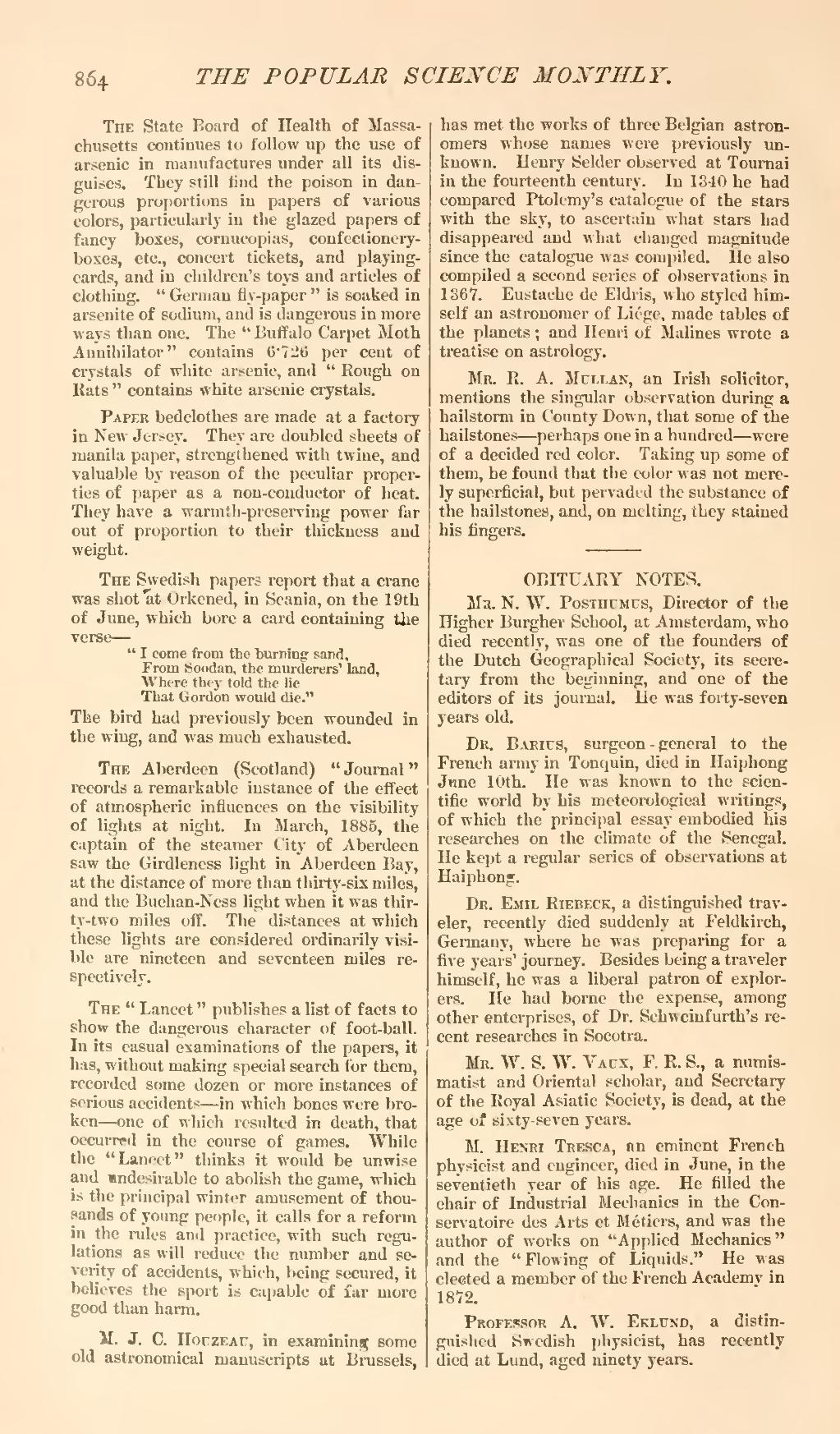The State Board of Health of Massachusetts continues to follow up the use of arsenic in manufactures under all its disguises. They still find the poison in dangerous proportions in papers of various colors, particularly in the glazed papers of fancy boxes, cornucopias, confectionery boxes, etc., concert tickets, and playing cards, and in children's toys and articles of clothing. "German fly-paper" is soaked in arsenite of sodium, and is dangerous in more ways than one. The "Buffalo Carpet Moth Annihilator" contains 6·7126 per cent of crystals of white arsenic, and "Rough on Hats" contains white arsenic crystals.
Paper bedclothes are made at a factory in New Jersey. They are doubled sheets of manila paper, strengthened with twine, and valuable by reason of the peculiar properties of paper as a non-conductor of heat. They have a warmth-preserving power far out of proportion to their thickness and weight.
The Swedish papers report that a crane was shot at Orkened, in Scania, on the 19th of June, which bore a card containing the verse
"I come from the burning sand,
From Soodan, the murderers' land,
Where they told the lie
That Gordon would die."
The bird had previously been wounded in the wing, and was much exhausted.
The Aberdeen (Scotland) "Journal" records a remarkable instance of the effect of atmospheric influences on the visibility of lights at night. In March, 1885, the captain of the steamer City of Aberdeen saw the Girdleness light in Aberdeen Bay, at the distance of more than thirty-six miles, and the Buchan-Ness light when it was thirty-two miles off. The distances at which these lights are considered ordinarily visible are nineteen and seventeen miles respectively.
The "Lancet" publishes a list of facts to show the dangerous character of foot-ball. In its casual examinations of the papers, it has, without making special search for them, recorded some dozen or more instances of serious accidents—in which bones were broken—one of which resulted in death, that occurred in the course of games. While the "Lancet" thinks it would be unwise and undesirable to abolish the game, which is the principal winter amusement of thousands of young people, it calls for a reform in the rules and practice, with such regulations as will reduce the number and severity of accidents, which, being secured, it believes the sport is capable of far more good than harm.
M. J. C. Houzeau, in examining some old astronomical manuscripts at Brussels, has met the works of three Belgian astronomers whose names were previously unknown. Henry Selder observed at Tournai in the fourteenth century. In 1340 he had compared Ptolemy's catalogue of the stars with the sky, to ascertain what stars had disappeared and what changed magnitude since the catalogue was compiled. He also compiled a second series of observations in 1367. Eustache de Eldris, who styled himself an astronomer of Liége, made tables of the planets; and Henri of Malines wrote a treatise on astrology.
Mr. R. A. Mullan, an Irish solicitor, mentions the singular observation during a hailstorm in County Down, that some of the hailstones—perhaps one in a hundred—were of a decided red color. Taking up some of them, he found that the color was not merely superficial, but pervaded the substance of the hailstones, and, on melting, they stained his fingers.
Ms. N. W. Posthumus, Director of the Higher Burgher School, at Amsterdam, who died recently, was one of the founders of the Dutch Geographical Society, its secretary from the beginning, and one of the editors of its journal. He was forty-seven years old.
Dr. Barius, surgeon-general to the French army in Tonquin, died in Haiphong June 10th. He was known to the scientific world by his meteorological writings, of which the principal essay embodied his researches on the climate of the Senegal. He kept a regular series of observations at Haiphong.
Dr. Emil Riebeck, a distinguished traveler, recently died suddenly at Feldkirch, Germany, where he was preparing for a five years' journey. Besides being a traveler himself, he was a liberal patron of explorers. He had borne the expense, among other enterprises, of Dr. Schweinfurth's recent researches in Socotra.
Mr. W. S. W. Vaux, F. R. S., a numismatist and Oriental scholar, and Secretary of the Royal Asiatic Society, is dead, at the age of sixty-seven years.
M. Henri Tresca, an eminent French physicist and engineer, died in June, in the seventieth year of his age. He filled the chair of Industrial Mechanics in the Conservatoire des Arts et Métiers, and was the author of works on "Applied Mechanics" and the "Flowing of Liquids." He was elected a member of the French Academy in 1872.
Professor A. W. Eklund, a distinguished Swedish physicist, has recently died at Lund, aged ninety years.
